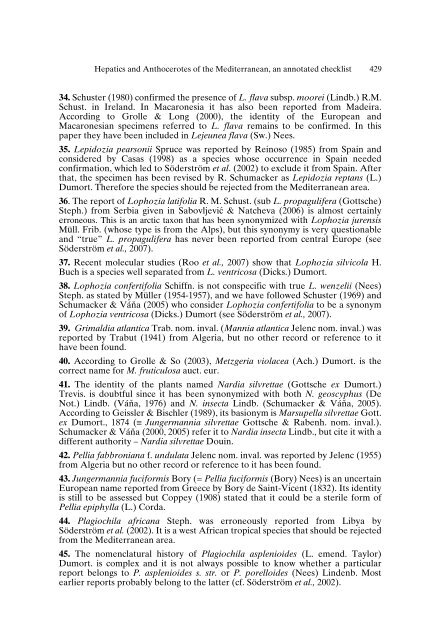Hepatics and Anthocerotes of the Mediterranean, an ... - NTNU
Hepatics and Anthocerotes of the Mediterranean, an ... - NTNU
Hepatics and Anthocerotes of the Mediterranean, an ... - NTNU
You also want an ePaper? Increase the reach of your titles
YUMPU automatically turns print PDFs into web optimized ePapers that Google loves.
<strong>Hepatics</strong> <strong><strong>an</strong>d</strong> <strong>Anthocerotes</strong> <strong>of</strong> <strong>the</strong> <strong>Mediterr<strong>an</strong>e<strong>an</strong></strong>, <strong>an</strong> <strong>an</strong>notated checklist 42934. Schuster (1980) confirmed <strong>the</strong> presence <strong>of</strong> L. flava subsp. moorei (Lindb.) R.M.Schust. in Irel<strong><strong>an</strong>d</strong>. In Macaronesia it has also been reported from Madeira.According to Grolle & Long (2000), <strong>the</strong> identity <strong>of</strong> <strong>the</strong> Europe<strong>an</strong> <strong><strong>an</strong>d</strong>Macaronesi<strong>an</strong> specimens referred to L. flava remains to be confirmed. In thispaper <strong>the</strong>y have been included in Lejeunea flava (Sw.) Nees.35. Lepidozia pearsonii Spruce was reported by Reinoso (1985) from Spain <strong><strong>an</strong>d</strong>considered by Casas (1998) as a species whose occurrence in Spain neededconfirmation, which led to Söderström et al . (2002) to exclude it from Spain. Afterthat, <strong>the</strong> specimen has been revised by R. Schumacker as Lepidozia rept<strong>an</strong>s (L.)Dumort. Therefore <strong>the</strong> species should be rejected from <strong>the</strong> <strong>Mediterr<strong>an</strong>e<strong>an</strong></strong> area.36. The report <strong>of</strong> Lophozia latifolia R. M. Schust. (sub L. propagulifera (Gottsche)Steph.) from Serbia given in Sabovljevi † & Natcheva (2006) is almost certainlyer roneous. This is <strong>an</strong> arctic taxon that has been syn onymized with Lophozia jurensisMüll. Frib. (whose type is from <strong>the</strong> Alps), but this synonymy is very questionable<strong><strong>an</strong>d</strong> “true” L. propagulifera has never been reported from central Europe (seeSöderström et al., 2007).37. Recent molecular studies (Roo et al., 2007) show that Lophozia silvicola H.Buch is a species well separated from L. ventricosa (Dicks.) Dumort.38. Lophozia confertifolia Schiffn. is not conspecific with true L. wenzelii (Nees)Steph. as stated by Müller (1954-1957), <strong><strong>an</strong>d</strong> we have followed Schuster (1969) <strong><strong>an</strong>d</strong>Schumacker & Vá≈ a (2005) who consider Lophozia confertifolia to be a synonym<strong>of</strong> Lophozia ventricosa (Dicks.) Dumort (see Söderström et al., 2007).39. Grimaldia atl<strong>an</strong>tica Trab. nom. inval. ( M<strong>an</strong>nia atl<strong>an</strong>tica Jelenc nom. inval.) wasreported by Trabut (1941) from Algeria, but no o<strong>the</strong>r record or reference to ithave been found.40. According to Grolle & So (2003), Metzgeria violacea (Ach.) Dumort. is <strong>the</strong>correct name for M. fruticulosa auct. eur.41. The identity <strong>of</strong> <strong>the</strong> pl<strong>an</strong>ts named Nardia silvrettae (Gottsche ex Dumort.)Trevis. is doubtful since it has been synonymized with both N. geoscyphus (DeNot.) Lindb. (Vá≈ a, 1976) <strong><strong>an</strong>d</strong> N. insecta Lindb. (Schumacker & Vá≈ a, 2005).According to Geissler & Bischler (1989), its basionym is Marsupella silvrettae Gott.ex Dumort., 1874 ( ≡ Jungerm<strong>an</strong>nia silvrettae Gottsche & Rabenh. nom. inval.).Schumacker & Vá≈ a (2000, 2005) refer it to Nardia insecta Lindb., but cite it with adifferent authority – Nardia silvrettae Douin.42. Pellia fabbroni<strong>an</strong>a f. undulata Jelenc nom. inval. was reported by Jelenc (1955)from Algeria but no o<strong>the</strong>r record or reference to it has been found.43. Jungerm<strong>an</strong>nia fuciformis Bory (= Pellia fuciformis (Bory) Nees) is <strong>an</strong> uncertainEurope<strong>an</strong> name reported from Greece by Bory de Saint-Vicent (1832). Its identityis still to be assessed but Coppey (1908) stated that it could be a sterile form <strong>of</strong>Pellia epiphylla (L.) Corda.44. Plagiochila afric<strong>an</strong>a Steph. was erroneously reported from Libya bySöderström et al. (2002). It is a west Afric<strong>an</strong> tropical species that should be rejectedfrom <strong>the</strong> <strong>Mediterr<strong>an</strong>e<strong>an</strong></strong> area.45. The nomenclatural history <strong>of</strong> Plagiochila asplenioides (L. emend. Taylor)Dumort. is complex <strong><strong>an</strong>d</strong> it is not always possible to know whe<strong>the</strong>r a particularreport belongs to P. asplenioides s. str. or P. porelloides (Nees) Lindenb. Mostearlier reports probably belong to <strong>the</strong> latter (cf. Söderström et al., 2002).






